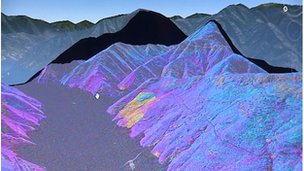Mapping the planet’s ups and downs
Published: 23 August 2013
Researchers at the University of Glasgow are using a new technique to respond to natural disasters around the world and manage their impact.
Researchers at the University of Glasgow are using a new technique known as interferometric synthetic aperture radar (InSAR) to monitor natural disasters around the world and manage their impact.
InSAR scans the Earth from space looking for points that are prone to surface changes and monitor their movement over time. It is hoped that the technology will play a considerable role in predicting where natural disasters such as volcanic eruptions and landslides may take place and help save lives.
 Led by Dr Zhenhong Li at the University of Glasgow’s School of Geographical and Earth Sciences, the team are looking at the surface of our planet from space and using satellites to track changes in the Earth’s surface that may otherwise be unnoticeable.
Led by Dr Zhenhong Li at the University of Glasgow’s School of Geographical and Earth Sciences, the team are looking at the surface of our planet from space and using satellites to track changes in the Earth’s surface that may otherwise be unnoticeable.
PhD student, Andrew Singleton, said: "We take one radar image taken at a certain time, and then a few days later we take a second radar image. Between those two time periods we can detect elevation changes in the Earth's surface.
"Obviously that has many applications for earthquakes and volcanoes. But my particular project focuses on landslide movements."
On the ground the full extent may be masked by vegetation. But from orbit InSAR lays it bare, and the Glasgow team's modelling techniques mean authorities can be forewarned, limiting the impact of some natural disasters.
Dr Li has also applied the techniques to one of the unexpected side effects of a growing Chinese economy: subsidence. He has measured the effects of coal mining, and of the unchecked extraction of groundwater.
He has also been able to quickly assess the effects of natural disasters like the Yushu earthquake which killed thousands of people in north-western China in 2010. Within hours of receiving radar data from the disaster area he was able to map the extent of the rupture in the Earth's surface.
"It only took me - a single researcher - two hours to produce these in the office," he says. "But it took our Chinese colleagues two weeks in the field to collect all the measurements."
For more information please contact the University of Glasgow's Media Relations Office: 01413303535, or media@glasgow.ac.uk.
First published: 23 August 2013
<< August

